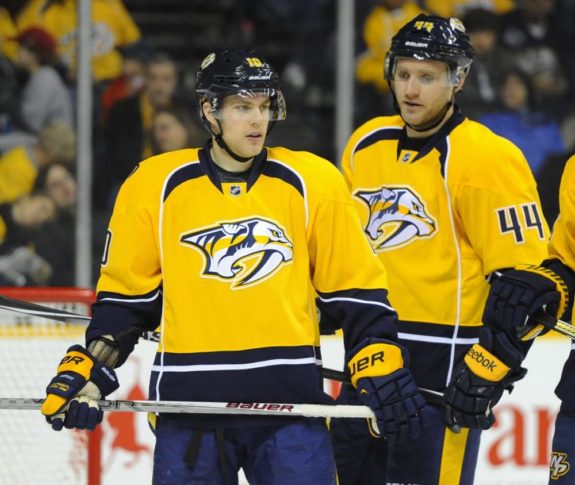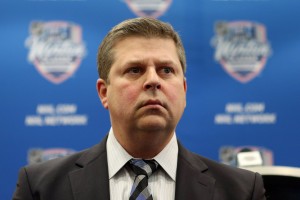On February 15, the Nashville Predators acquired defenseman Cody Franson and forward Michael Santorelli from the Toronto Maple Leafs in exchange for Nashville’s 2015 first round pick and forwards Brendan Leipsic and Olli Jokinen.
At the time, the Preds were the best team in the NHL with the second ranked Anaheim Ducks trailing five points behind. Following the trade, however, Nashville dipped in the standings and finished the remaining 26 games of the regular season with a mediocre 9-13-4 record. Their President’s Trophy hopes ended as they placed sixth in the League and second in the Central Division at the end of the year.

Fair or unfair, the acquisition of Franson and Santorelli will be called out as one of the reasons for Nashville’s demise. Neither had the significant impact general manager David Poile hoped for in their short stint with the Predators.
Santorelli had just 4 points (1 goal, 3 assists) and a -7 rating in 22 regular season games and scored once in four games during the playoffs. Prior to arriving in Nashville, the center tallied 29 points (11 g, 18 a) and a +7 rating in 57 games for the Leafs. Along with Santorelli’s offense, his ice time dropped from 14:57 to 12:54 on average per game from Toronto to Nashville.
Though a drop in ice time does have an effect on how many scoring chances created, Santorelli’s abysmal offense unfortunately does not get much flak because he gets overshadowed by Franson.
The purpose behind acquiring Franson was to solidify the defense while Ryan Ellis was suffering from a lower-body injury that kept him out 24 games this season. When Ellis returned, head coach Peter Laviolette had a problem on his hands. Both are right-handed defenders, and both were too talented to not be in the lineup. On most nights, the Preds had four rightys and just two leftys.
From Adam Vingan of The Tennessean:
“I think to be very honest, the fact that Franson was a right-handed shot — and the lefty-righty (defense pairs) all year (were) working really good for us — the righty-righty thing was, not making an excuse, but it wasn’t the perfect situation for Franson or for us,” Poile said. “I think when Shea went down (with a dislocated kneecap) and Franson got in there, and then he got to play in a lefty-righty situation, I think he played a lot better.
“Our defense was very good this year, and I think in the playoffs he played better than he did maybe sometimes in the regular season. It wasn’t a perfect fit to be very honest and — bottom line — it wasn’t like we didn’t know that before we made the trade, but we were hoping it would work probably a little bit better.”
Not only were Franson and Ellis the same handidness, they also played similar roles. The only difference was Ellis was more efficient on both sides of the puck. Without Ellis in the lineup, Franson’s average time on ice was 17:40; but with Ellis in the lineup, it was 15:25. The 2:15 drop in ice time with Ellis in the lineup is because Franson was the odd man out in Laviolette’s power play units. The defensive units included Shea Weber with Roman Josi and Seth Jones with Ellis. Franson, who led all Nashville defenders in power play points with 17 (5 g, 12 a), was somehow left out despite the power play clearly being one of his strengths.
With Ryan Ellis back, Cody Franson is basically a No. 6 that gets no PP time. What in the world was the point of that trade?
— Dave Lozo (@DaveLozo) March 15, 2015
With the Predators, Franson tallied just 4 points (1 g, 3 a) in 23 regular season games and added 2 assists in 5 playoff games.
The Real Winner: Toronto
In February, Nashville was the clear winner of the trade. They had a stacked roster poised to make a legitimate Stanley Cup run. As the season continued with Franson and Santorelli, I began to scratch my head thinking about the deal. It proved not work after getting eliminated in the first round in six games by the Chicago Blackhawks. Now, Nashville is left disappointed with an early round exit and without a first round pick in the upcoming draft and coveted prospect Brendan Leipsic.

Toronto had a change of heart, too. After the trade, THW writer Adam Raymakers called the deal another failure by now former Leafs GM Dave Nonis. Knowing Toronto had to get rid of Franson and Santorelli — both unrestricted free agents unlikely to re-sign with the Leafs — Nonis got what he could to look towards the future. The move made the Leafs’ roster weak, which assisted in the tanking for a high draft pick. Also, Nashville’s early round exit gives Toronto a middle of the pack first round pick.
The Maple Leafs, if they wish to stockpile centres (seeing that the team badly needs elite-level prospects in this key position), would now potentially be able to target the likes of Travis Konecny and/or Joel Eriksson Ek with their second first round selection that is acquired from Nashville earlier, an improbable scenario if the club were to select in the late 20’s. Of course, Toronto may well opt for the best available player on its draft board at that point (which may not be a centre) but no matter which of these scenarios unfold, Toronto would be able to choose a player that is considerably higher-ranked on its draft board due to the Predators’ somewhat unexpected early-exit from the playoffs.
Adding promising 20-year-old Brendan Leipsic was another great aspect of the trade for Toronto. Leipsic was the CHL’s leading scorer in 2012-13 with 120 points (49 g, 71 a) in 68 games. In his first AHL season, he had 55 points (14 g, 41 a) in 74 games. There is a lot to like from the 5-foot-10, 176lbs forward.
An overlooked part of the trade was Nonis turning Jokinen in for a depth centerman Joakim Lindstrom. Jokinen played six games in Toronto before he was traded to the St. Louis Blues for Lindstrom and a conditional sixth round pick.
The winner of the deal is Toronto, so give Nonis some credit.
Subscribe to our Predators stories to get email updates every time a new story is published.
Colin Fitts is a Nashville Predators staff writer for The Hockey Writers. You can follow him on Twitter, @FittsTHW.